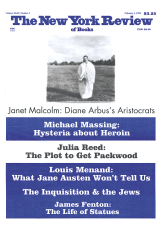In response to:
The Pioneer Defended from the December 21, 1995 issue
To the Editors:
May I make some corrections to my review of Gerald L. Geison’s book The Private Science of Louis Pasteur [NYR, December 21, 1995], in the light of comments received. I wrote that Pasteur’s exposure of cultures of anthrax bacilli to air induced genetic mutations which rendered the bacteria less virulent. Dr. Maxine Schwartz, the present director of the Pasteur Institute in Paris, tells me that this weakening is due to loss, rather than mutation of genes (loss of one or two plasmids which are pieces of circular DNA separate from the main chromosome).
I wrote that live attenuated vaccines were more effective than dead ones. Dr. Schwartz points out to me that this is often, but not always, the case. For example, “dead” vaccines, such as diphtheria, tetanus, hepatitis B, or Pasteur’s own rabies vaccines, are very effective, and Sabin’s live polio vaccine is preferred over Salk’s dead one, mainly because it can be administered by mouth rather than having to be injected.
I wrote in my review that Joseph Meister, whose life Pasteur had saved after he had been bitten by a rabid dog, killed himself in June 1940 rather than open the crypt where Pasteur lies buried to the invading Germans. I had found this report in René Dubos’s biography of Pasteur. Dr. David Eisenberg of the University of California in Los Angeles has written to me that a French colleague, Dr. Georges Cohen, told him the following: Dr. Cohen happens to live in the same apartment building in Paris as Joseph Meister’s son, a retired naval office, who said it was true that his father, being of Alsacian origin, took his life in June 1940 in despondency over the German invasion, but his suicide was not related to Pasteur’s burial crypt.
M.F. Perutz
MRC Laboratory of Molecular Biology
Cambridge, England
This Issue
February 1, 1996



